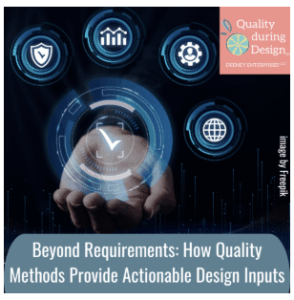
Beyond Requirements: How Quality Methods Provide Actionable Design Inputs

We explore the critical transition from concept development to engineering solutions in product development, highlighting quality tools that bridge the gap between customer needs and technical design inputs.
- Quality engineering tools help translate concept development insights into design requirements
- Results from concept development help focus engineering efforts on what matters most
- The goal is continuing the conversation from concept development through product design
The often-overlooked transition
In product development, there’s a critical transition point that often gets overlooked: the moment when we move from understanding customer needs to actually engineering solutions. This transition from the “problem space” to the “solution space” represents a significant shift in thinking and approach. After concept development (learning about customer needs, desired benefits, potential symptoms, and use scenarios) many teams struggle with how to translate this wealth of information into concrete design inputs.
Bridge the gap with quality and reliability tools
Quality engineering and reliability tools play a crucial role in bridging this gap. Rather than relying solely on memory or making intuitive leaps from concept to design, these tools provide structured approaches to transform customer-focused insights into technical requirements. This isn’t a one-time process but an iterative one that extends the conversation started during concept development into the design phase, ensuring customer priorities remain central to technical decisions.
Tree diagrams
Tree diagrams represent one powerful approach to this translation process. Consider a simple example: during concept development, you might identify that customers want a “simple unpacking method” for your product. Through a tree diagram, you can break this vague driver into specific design inputs. Perhaps you discover two potential solutions: arranging parts in the box according to assembly order or ensuring access to assembly instructions before unpacking parts. The tree diagram helps distinguish between what needs to be accomplished (a design requirement) versus how it might be accomplished (a specific implementation). This clarity prevents prematurely locking into implementation details while keeping focus on essential customer needs.
Matrices
Another valuable approach involves using matrices inspired by Quality Function Deployment (QFD) methodology. These matrices allow teams to map relationships between customer-desired features and potential design inputs. By evaluating the strength of these relationships (strong, medium, or weak), teams can identify gaps, redundancies, and priorities. Are there customer features with no strong relationship to any design input? Are there proposed requirements that don’t address any customer need? The visual nature of these matrices facilitates team discussions and drives consensus on design priorities that balance customer satisfaction with technical feasibility.
Beyond Benefits: FMEAs and Task Analysis
Beyond tree diagrams and matrices, teams can leverage other quality tools to further refine their approach. Risk analyses through System FMEAs help address potential failure modes identified during concept development. Task analyses using Perception-Cognition-Action frameworks evaluate how customers interact with process outputs and control inputs. These structured approaches ensure that information gathered during concept development continues to inform design decisions throughout product development, focusing engineering efforts on what matters most to customers.
Use them when they’re needed to help with design
The beauty of these quality tools lies in their ability to maintain continuity between concept development and detailed design. Rather than treating concept development as a completed phase whose outputs are filed away, these tools ensure that the rich, prioritized data about customer experiences directly translates into actionable design inputs.
By deciding what you must learn next and selecting appropriate quality tools to address those questions, you create a seamless progression from understanding customer needs to delivering solutions that truly satisfy them. This thoughtful translation process ultimately leads to products that customers love, with less rework and fewer costly design changes later in development.
Other podcast episodes you may like:
Prioritizing Technical Requirements with a House of Quality
Quality as a Strategic Asset vs. Quality as a Control
Leave a Reply